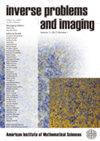Refined stability estimates in electrical impedance tomography with multi-layer structure
IF 1.5
4区 数学
Q2 MATHEMATICS, APPLIED
引用次数: 2
Abstract
In this paper we study the inverse problem of determining an electrical inclusion in a multi-layer composite from boundary measurements in 2D. We assume the conductivities in different layers are different and derive a stability estimate for the linearized map with explicit formulae on the conductivity and the thickness of each layer. Intuitively, if an inclusion is surrounded by a highly conductive layer, then, in view of "the principle of the least work", the current will take a path in the highly conductive layer and disregard the existence of the inclusion. Consequently, a worse stability of identifying the hidden inclusion is expected in this case. Our estimates indeed show that the ill-posedness of the problem increases as long as the conductivity of some layer becomes large. This work is an extension of the previous result by Nagayasu-Uhlmann-Wang[15], where a depth-dependent estimate is derived when an inclusion is deeply hidden in a conductor. Estimates in this work also show the influence of the depth of the inclusion.多层结构电阻抗层析成像的精细稳定性估计
本文研究了利用二维边界测量确定多层复合材料中电包裹体的反问题。我们假设不同层的电导率是不同的,并根据电导率和各层厚度的显式公式推导出线性化图的稳定性估计。直观地看,如果包裹体被高导电层包围,那么根据“最小功原理”,电流将在高导电层中走一条路径,忽略包裹体的存在。因此,在这种情况下,识别隐藏内含物的稳定性较差。我们的估计确实表明,只要某一层的电导率变大,问题的不适定性就会增加。这项工作是Nagayasu-Uhlmann-Wang[15]先前结果的扩展,其中当包含物深埋在导体中时推导出深度相关估计。这项工作中的估计也显示了包含深度的影响。
本文章由计算机程序翻译,如有差异,请以英文原文为准。
求助全文
约1分钟内获得全文
求助全文
来源期刊

Inverse Problems and Imaging
数学-物理:数学物理
CiteScore
2.50
自引率
0.00%
发文量
55
审稿时长
>12 weeks
期刊介绍:
Inverse Problems and Imaging publishes research articles of the highest quality that employ innovative mathematical and modeling techniques to study inverse and imaging problems arising in engineering and other sciences. Every published paper has a strong mathematical orientation employing methods from such areas as control theory, discrete mathematics, differential geometry, harmonic analysis, functional analysis, integral geometry, mathematical physics, numerical analysis, optimization, partial differential equations, and stochastic and statistical methods. The field of applications includes medical and other imaging, nondestructive testing, geophysical prospection and remote sensing as well as image analysis and image processing.
This journal is committed to recording important new results in its field and will maintain the highest standards of innovation and quality. To be published in this journal, a paper must be correct, novel, nontrivial and of interest to a substantial number of researchers and readers.
 求助内容:
求助内容: 应助结果提醒方式:
应助结果提醒方式:


